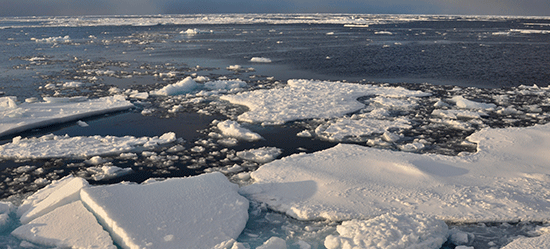Salt Water Ice Activity For Teachers
The goal of this experiment is to explore the differences between freshwater ice and sea ice. This experiment allows the students to make observations about the two types of ice.
Tips for Classroom Implementation
Time Required: Two 50-minute class periods on two different days (one to prepare and freeze the ice cores, the other to add food coloring and observe its movement through or around the ice).
Tips:
- Read Frozen Life companion story as a class before beginning this activity. It will teach students about brine channels in sea ice and the importance of plankton in arctic ecosystems.
- Place a container under the ice to collect water as it melts.
Extensions
- Conduct experiment with many different concentrations of salt to see how the dispersion differs between ice samples.
- Research and observe how long it takes for water with different concentration of salt to freeze. At 32˚F (0˚C) the fresh water will freeze but with salt water it will not freeze at this temperature.
- Research and observe the effects of temperature on ice. Have students touch both types of ice (before adding food coloring) and see if they can feel a difference. The salt water ice will feel colder because when salt is added to water it lowers the freezing point. Water will continue to get colder until it reaches its freezing point (depending on the salt concentration, typical sea water at 34ppt salinity would freeze at 28.65˚F (-1.86˚C)) so it will be colder than fresh water.
Objective
- Students will compare and contrast the differences between sea and freshwater ice.

Arizona Science Standards
Arizona Science Standards
Strand 1: Inquiry Process
Concept 1: Observations, Questions, and Hypotheses
K-4: Observe, ask questions, and make predictions.
Concept 2: Scientific Testing (Investigating and Modeling)
K-4: Participate in planning and conducting investigations, and recording data.
Strand 4: Life Science
Concept 3: Organisms and Environments
K-4: Understand the relationships among various organisms and their environment.
Common Core Standards:
6-8.RST.3 Follow precisely a multistep procedure when carrying out experiments, taking measurements, or performing technical tasks.
Next Generation Standards:
5-LS2-1. Develop a model to describe the movement of matter among plants, animals, decomposers, and the environment. (For this one, have students walk through the food webs in the Frozen Life companion story.)
Additional image from Wikimedia via Patrick Kelley.
Read more about: When Water Gets Icy
Bibliographic details:
- Article: Salt Water Ice Activity For Teachers
- Author(s): Dr. Biology
- Publisher: Arizona State University School of Life Sciences Ask A Biologist
- Site name: ASU - Ask A Biologist
- Date published: 15 Jul, 2014
- Date accessed:
- Link: https://askabiologist.asu.edu/activities/experiments/when-water-gets-icy/for-teachers
APA Style
Dr. Biology. (Tue, 07/15/2014 - 12:14). Salt Water Ice Activity For Teachers. ASU - Ask A Biologist. Retrieved from https://askabiologist.asu.edu/activities/experiments/when-water-gets-icy/for-teachers
Chicago Manual of Style
Dr. Biology. "Salt Water Ice Activity For Teachers". ASU - Ask A Biologist. 15 Jul 2014. https://askabiologist.asu.edu/activities/experiments/when-water-gets-icy/for-teachers
Dr. Biology. "Salt Water Ice Activity For Teachers". ASU - Ask A Biologist. 15 Jul 2014. ASU - Ask A Biologist, Web. https://askabiologist.asu.edu/activities/experiments/when-water-gets-icy/for-teachers
MLA 2017 Style

A piece of sea ice core collected in the Arctic with blue food coloring added.
Download the When Water Gets Icy experiment packet.
Be Part of
Ask A Biologist
By volunteering, or simply sending us feedback on the site. Scientists, teachers, writers, illustrators, and translators are all important to the program. If you are interested in helping with the website we have a Volunteers page to get the process started.

